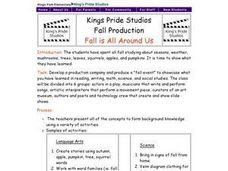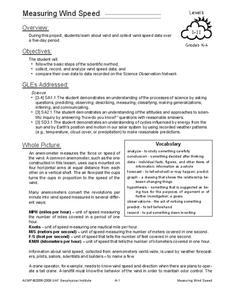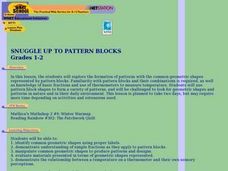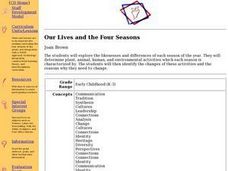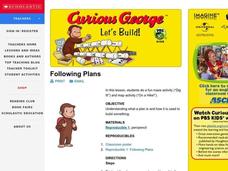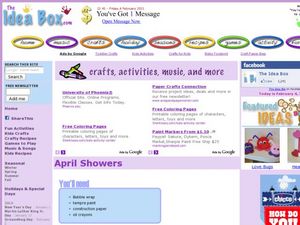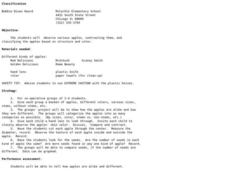Curated OER
Introduction to Economics
Students demonstrate an understanding of the concepts of unlimited wants and limited resources. They participate in an activity using money to purchase goods and services. Students evaluate benefits and costs resulting from personal...
Curated OER
Mighty Earth Movers
Note that although the publisher lists almost all of the Common Core standards for both math and language arts, you will most likely want to take the general topic and choose which area to focus on. Regarding math, pupils measure worms...
Curated OER
Fall is All Around Us
Pupils develop and create a production company and produce a fall event that demonstrates what they have learned in various subject areas. STudents create stories, complete a venn diagram comparing fall and summer, graph and measure...
Curated OER
Peter The Butterfly
Young scholars complete an interdisciplinary unit chronicling the life cycle and movement patterns of the butterfly. Through language arts, mathematics, and science activities, students identify various types of butterflies and document...
Curated OER
Introduction to Time
Students explore the concept of time. Through discussion and artistic projects, they define time in their own words and tell how it is used to represent the seasons. Students draw a picture to portray time as it elapses during the...
Curated OER
Look At Those Leaves!
Students sort tree leaves. In this plant biology instructional activity, students collect leaves and group them according to size, shape, and color. Students discuss their observations.
Curated OER
Water Filtering
Young scholars investigate how polluted water is filtered so people can use this recycled resource. They conduct an experiment in which they put "polluted" water through a filtering system. They investigate what happens at a water...
Curated OER
Slippery, Slippery Ice
Young scholars investigate how salt affects ice by experimenting in class. In this water properties lesson, students utilize a penny, salt and pans of ice to examine the sliding ability of a penny across a layer of ice. Young...
Curated OER
Measuring Wind Speed
Young scholars study wind speed and collect wind speed data. In this wind speed lesson, students visit a website to learn about the local wind speed forecast for their week. Young scholars discuss wind and wind speed. Students collect...
Curated OER
NOVA Online/Einstein Revealed
Welcome to the companion Web site to the NOVA program "Einstein Revealed," originally broadcast in October, 1996. This two-hour special presents a penetrating profile of Albert Einstein, who contributed more than any other scientist to...
Curated OER
Summertime -- Camping Memory Game
Students discuss the items needed to camp outside. They identify objects in a backpack and tell what the item could be used for. They hide the objects throughout the room and they are to find them.
Curated OER
Maple Syrup Production
Students examine the steps of maple sugar production and the labor and effort involved from the tree to the final product. They participate in a taste test game, and if they have access to maple trees, make their own syrup and sugar.
Curated OER
Snuggle Up To Pattern Blocks
Students view and discuss a video about the use of pattern block shapes to form pictures. They, in groups, form garden and quilt designs using pattern blocks and then decorate the room with their art.
Curated OER
Where Does the Green Go?
Students investigate why green leaves change colors in the fall. They press leaves and write a poem, create a chlorophyll leaf print, take a nature walk, and create a leaf shape poster.
Curated OER
Embrace Space
Students use the internet to gather informatino about the solar system and space. In groups, they create a slideshow in which they use illustrations from the internet and include their own text. They complete the lesson by going on a...
Curated OER
The Unknown Secrets of the Rain Forest
Young scholars explore the rain forest and where they are located. Students examine why the rain forests are important and what is happening to them. They investigate the water cycle and life cycle of a frog. Young scholars build a rain...
Curated OER
Our Lives and the Four Seasons
Students compare and contrast the four seasons. Using this information, they determine the plant, animal and environmental activities that can be enjoyed in each season. They discuss why the seasons must change and how humans adapt to them.
Curated OER
Children's Literature Across the Curriculum Ideas: Chickens Aren't the Only Ones
Students read Chickens Aren't the Only Ones by Ruth Heller. They complete a variety of cross-curricular activities surrounding the study of animals that come from eggs. Included are reading, art, math, science, writing, social studies,...
Curated OER
Let's Build
Students observe and discuss a picture of Curious George building a bridge and discuss what it means to build, plan and design a project. As a class, they list things they need to do in oder to build something and explore how a compass...
Curated OER
April Showers
In this April showers worksheet, students assist a raindrop in finding the best route to get through a maze to get to the flowers. Students color the raindrop and the flowers with appropriate colors.
Curated OER
Classification
Students explore classification. In this science lesson plan, students observe various apples, contrasting them, and classifying the apples based on structure and color.
Curated OER
Everything's Connected
Students explore how trash decomposes. In this ecosystem instructional activity, students discuss new vocabulary words, such as producers and consumers, and think critically to answer how landfills work.
Curated OER
Look at Those Leaves!
Students observe and sort tree leaves. In this plant biology lesson, students observe various types of leaves and identify the characteristics of each leaf. Students measure and sort leaves according to size and color.
Curated OER
Introduction to Seeds
Students investigate how to plant a seed. In this gardening lesson, students listen to the book I'm a Seed and research the materials needed to plant a seed. Students present the information they found.


